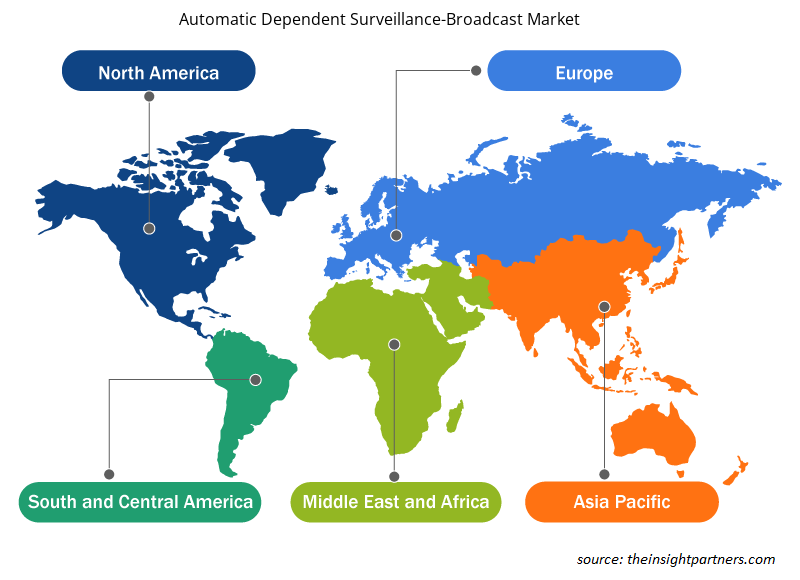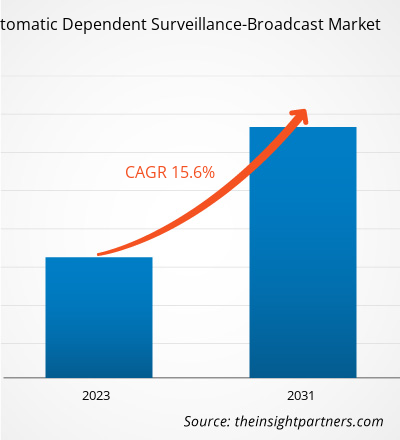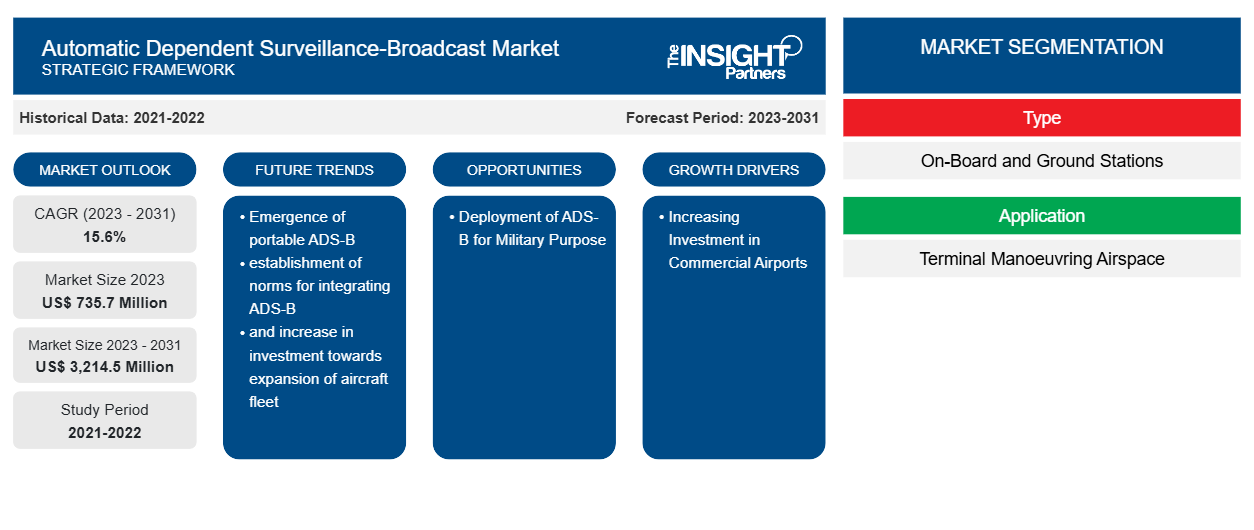Si prevede che la dimensione del mercato della sorveglianza-broadcast automatica dipendente raggiungerà i 3.214,5 milioni di dollari entro il 2031, rispetto ai 735,7 milioni di dollari del 2023. Si prevede che il mercato registrerà un CAGR del 15,6% nel 2023-2031. L'emergere dell'ADS-B portatile, l'istituzione di norme per l'integrazione dell'ADS-B e l'aumento degli investimenti per l'espansione della flotta di aeromobili sono tra le tendenze chiave che guidano il mercato della sorveglianza-broadcast automatica dipendente.CAGR of 15.6% in 2023–2031. The emergence of portable ADS-B, establishment of norms for integrating ADS-B, and increase in investment towards the expansion of aircraft fleet are among the key trends driving the automatic dependent surveillance-broadcast market.
Analisi del mercato della sorveglianza automatica dipendente-trasmissione
Il crescente numero di ordini e consegne di flotte di aeromobili in tutto il mondo, insieme ai mandati per l'uso di ADS-B, sta svolgendo un ruolo positivo nell'incrementare l'adozione di ADS-B. Inoltre, si prevede che l'aumento degli investimenti per aggiornare gli aeroporti commerciali con strutture e tecnologie avanzate alimenterà l'adozione di ADS-B. Inoltre, si prevede che i progetti approvati dalle autorità aeronautiche di paesi come gli Stati Uniti per l'uso di ADS-B in applicazioni militari forniranno ampie opportunità di crescita ai produttori di ADS-B durante il periodo di previsione. Inoltre, si prevede che l'emergere di ADS-B portatile per risparmiare sui costi di produzione e installazione dell'ADS-B standard contribuirà alla crescita del mercato.
Panoramica del mercato della sorveglianza automatica dipendente-trasmissione
ADS-B è una tecnica di sorveglianza in cui non è necessario alcuno stimolo esterno. Questa tecnica dipende dai veicoli e dagli aeromobili aeroportuali per trasmettere la loro posizione, identità e altre informazioni ottenute da sistemi di bordo come GNSS. ADS-B presenta caratteristiche tra cui elevate prestazioni, sostenibilità ambientale, interoperabilità globale e maggiore capacità e sicurezza migliorata. Inoltre, l'infrastruttura di sorveglianza ADS-B è meno costosa della tecnologia radar primaria , il che la rende conveniente per scopi di sorveglianza. Si prevede che un aumento degli investimenti verso l'espansione delle flotte di aeromobili in tutto il mondo guiderà la crescita del mercato della sorveglianza automatica dipendente-trasmissione durante il periodo di previsione. Inoltre, si prevede che l'aviazione commerciale aumenterà nei prossimi anni a causa del crescente numero di viaggiatori aerei e dell'approvvigionamento di nuovi aeromobili. In Nord America, Europa e nella regione Asia-Pacifico, il traffico passeggeri aereo è aumentato nel tempo, il che sta alimentando la domanda di aeromobili commerciali. In Asia-Pacifico, principalmente in Cina e India, gli aeromobili commerciali per i viaggi nazionali hanno dimostrato di essere convenienti. Si prevede che ciò alimenterà la crescita del mercato nei prossimi anni.
Personalizza questo report in base alle tue esigenze
Riceverai la personalizzazione gratuita di qualsiasi report, comprese parti di questo report, o analisi a livello nazionale, pacchetto dati Excel, oltre a usufruire di grandi offerte e sconti per start-up e università
- Scopri le principali tendenze di mercato in questo rapporto.Questo campione GRATUITO includerà analisi di dati che spaziano dalle tendenze di mercato alle stime e alle previsioni.
Driver e opportunità del mercato della sorveglianza automatica dipendente-trasmissione
Aumento degli investimenti negli aeroporti commerciali
Con il crescente numero di aeroporti commerciali in tutto il mondo, sta aumentando anche l'adozione di ADS-B. Questa tecnologia è attualmente in esecuzione in regioni come Europa, Nord America e Asia. Con l'aumento delle infrastrutture degli aeroporti commerciali o la ristrutturazione di aeroporti esistenti, sta aumentando anche il numero di apparecchiature di terra, come i terminal ATC, sfruttando così ADS-B per il tracciamento degli aeromobili. In paesi come la Cina, l'aeroporto internazionale di Chongqing Jiangbei (CQIA) è tra i 10 aeroporti più grandi, che sta subendo un significativo piano di espansione. Grazie agli investimenti, l'aeroporto riceverà lo status di hub aereo internazionale e sarà il più grande nella Cina occidentale entro il 2035. Un altro aeroporto in Cina che sta assistendo a investimenti per sviluppare un aeroporto è l'aeroporto internazionale di Pechino Daxing.ATC terminals, is also increasing, thus taking advantage of ADS-B for tracking aircraft. In countries such as China, Chongqing Jiangbei International Airport (CQIA) is among the 10th largest airports, which is undergoing a significant expansion plan. From investment, the airport is to receive international air hub status and will be the largest in western China by 2035. Another airport in China witnessing investment to develop an airport is Beijing Daxing International Airport.
SE Lithuanian Airports ha firmato un accordo del valore di 81 milioni di $ USA (70 milioni di €) di prestito con la Nordic Investment Bank per modernizzare i tre aeroporti principali della Lituania: Vilnius, Kaunas e Palanga. Si prevede che tali progetti relativi alla modernizzazione degli aeroporti promuoveranno l'adozione di tecnologie avanzate, tra cui ADS-B. I dati seguenti rappresentano gli investimenti in termini di costruzione/ammodernamento/modernizzazione degli aeroporti in regioni come il Nord America che registrerà 20 miliardi di $ USA, l'APAC che registrerà 90,86 miliardi di $ USA, il SAM che registrerà 1,12 miliardi di $ USA e il MEA che registrerà 42,92 miliardi di $ USA per lo sviluppo dei propri aeroporti.Palanga. Such projects related to the modernization of airports are projected to propel the adoption of advanced technologies, including ADS-B. The following data represents the investments in terms of constructing/upgrading/modernizing airports across regions such as North America to witness US$ 20 billion, APAC to see US$ 90.86 billion, SAM to experience US$ 1.12 billion, and MEA to US$ 42.92 billion for the development of their airports.
Si prevede che gli investimenti menzionati per costruire nuovi aeroporti e modernizzare quelli esistenti aumenteranno l'impiego di tecniche di sorveglianza avanzate per tracciare meglio gli aeromobili . Pertanto, stanno contribuendo positivamente all'impiego di ADS-B, che sta guidando il mercato della sorveglianza-broadcast dipendente automatica.
Utilizzo dell'ADS-B per scopi militari
L'ambito di ADS-B si sta espandendo per garantire il tracciamento preciso degli aeromobili. Con i continui progressi tecnologici, l'integrazione di ADS-B sta aumentando tra gli aeromobili militari. Secondo l'aeronautica militare statunitense, si prevede che il Pentagono avrà 2.936 aeromobili dotati di ADS-B Out, guidati dal mandato della FAA. Entro il 2025, il Dipartimento della Difesa statunitense mira ad avere quasi il 62% dei propri aeromobili dotati di ADS-B (Out), tra cui oltre il 67% degli elicotteri, il 35% degli aerei da combattimento e il 100% di aerei da mobilità, addestramento, comando e controllo/intelligence, sorveglianza e ricognizione (C2/ISR). Si prevede che circa 1.129 elicotteri, 259 aeromobili C2/ISR, 923 aeromobili da mobilità e 625 addestratori saranno dotati di ADS-B secondo l'aeronautica militare. Nel DoD, gli aerei che si prevede riceveranno ADS-B Out includono Boeing C-17 Globemasters, elicotteri Lockheed Martin UH-60 Black Hawk, trasporti C-130 e C-5. Si prevede che un dispiegamento così massiccio di ADS-B nell'aviazione militare influenzerà in modo efficace la crescita del mercato della sorveglianza-trasmissione automatica dipendente.
Analisi della segmentazione del rapporto di mercato della sorveglianza automatica dipendente-trasmissione
I segmenti chiave che hanno contribuito alla derivazione dell'analisi di mercato della sorveglianza-trasmissione automatica dipendente sono la tipologia e l'utente finale.
- In base al tipo, il mercato della sorveglianza-broadcast dipendente automatica è stato suddiviso in stazioni di bordo e stazioni di terra. Il segmento delle stazioni di bordo ha detenuto una quota di mercato maggiore nel 2023.
- In base all'applicazione, il mercato della sorveglianza-broadcast automatica dipendente è stato suddiviso in sorveglianza dello spazio aereo di manovra terminale (TMA) e sorveglianza aerea. Il segmento della sorveglianza aerea ha detenuto una quota di mercato maggiore nel 2023.
- Sulla base dei componenti, il mercato è stato segmentato in antenna, ricevitore, transponder e ricevitori terrestri ads-b. Il segmento transponder ha dominato il mercato nel 2023.
Analisi della quota di mercato della sorveglianza automatica dipendente-trasmissione per area geografica
L'ambito geografico del rapporto sul mercato della sorveglianza automatica dipendente-trasmissione è suddiviso principalmente in cinque regioni: Nord America, Europa, Asia Pacifico, Medio Oriente e Africa e Sud America.
Il Nord America ha dominato il mercato della sorveglianza-broadcast automatica dipendente nel 2023. Il Nord America è la regione tecnologicamente più avanzata, con importanti economie tra cui Stati Uniti, Canada e Messico. Queste economie sono classificate in base a standard di vita più elevati, elevati redditi individuali disponibili e rapidi progressi tecnologici nell'ingegneria aerospaziale e nella costruzione di aeroporti. La regione del Nord America comprende la più grande flotta di aerei commerciali e da difesa al mondo. Il gran numero di flotte commerciali e militari operative nell'arena nazionale e internazionale, insieme a un elevato valore medio di passeggeri per miglio percorso nella regione, ha alimentato la domanda di componenti di comunicazione per aeroporti e aeromobili. Le economie in tutta la regione hanno una presenza considerevole di aeroporti sia commerciali che militari. Alcuni stanno aggiornando ADS-B e sistemi associati in questi siti aeroportuali per applicazioni di ricezione del segnale sia a terra che a bordo di aeromobili.
Approfondimenti regionali sul mercato della sorveglianza automatica dipendente-trasmissione
Le tendenze regionali e i fattori che influenzano il mercato Automatic Dependent Surveillance-Broadcast durante il periodo di previsione sono stati ampiamente spiegati dagli analisti di Insight Partners. Questa sezione discute anche i segmenti e la geografia del mercato Automatic Dependent Surveillance-Broadcast in Nord America, Europa, Asia Pacifico, Medio Oriente e Africa e Sud e Centro America.

- Ottieni i dati specifici regionali per il mercato della sorveglianza automatica dipendente-trasmissione
Ambito del rapporto sul mercato della sorveglianza automatica dipendente-trasmissione
| Attributo del report | Dettagli |
|---|---|
| Dimensioni del mercato nel 2023 | 735,7 milioni di dollari USA |
| Dimensioni del mercato entro il 2031 | 3.214,5 milioni di dollari USA |
| CAGR globale (2023-2031) | 15,6% |
| Dati storici | 2021-2022 |
| Periodo di previsione | 2023-2031 |
| Segmenti coperti | Per tipo
|
| Regioni e Paesi coperti | America del Nord
|
| Leader di mercato e profili aziendali chiave |
|
Densità degli attori del mercato: comprendere il suo impatto sulle dinamiche aziendali
Il mercato Automatic Dependent Surveillance-Broadcast Market sta crescendo rapidamente, spinto dalla crescente domanda degli utenti finali dovuta a fattori quali l'evoluzione delle preferenze dei consumatori, i progressi tecnologici e una maggiore consapevolezza dei vantaggi del prodotto. Con l'aumento della domanda, le aziende stanno ampliando le loro offerte, innovando per soddisfare le esigenze dei consumatori e capitalizzando sulle tendenze emergenti, il che alimenta ulteriormente la crescita del mercato.
La densità degli operatori di mercato si riferisce alla distribuzione di aziende o società che operano in un particolare mercato o settore. Indica quanti concorrenti (operatori di mercato) sono presenti in un dato spazio di mercato in relazione alle sue dimensioni o al valore di mercato totale.
Le principali aziende che operano nel mercato della sorveglianza automatica dipendente-trasmissione sono:
- Società Avidyne
- Aspen Avionics, Inc.
- Azienda aerospaziale Collins
- Sistemi di volo libero
- Garmin Italia
- Honeywell International Inc.
Disclaimer : le aziende elencate sopra non sono classificate secondo un ordine particolare.

- Ottieni la panoramica dei principali attori del mercato della sorveglianza automatica dipendente-trasmissione
Notizie e sviluppi recenti sul mercato della sorveglianza automatica dipendente-trasmissione
Il mercato della sorveglianza-broadcast automatica dipendente viene valutato raccogliendo dati qualitativi e quantitativi dopo la ricerca primaria e secondaria, che include importanti pubblicazioni aziendali, dati associativi e database. Di seguito è riportato un elenco degli sviluppi nel mercato per il mercato della sorveglianza-broadcast automatica dipendente e delle strategie:
- Nel giugno 2023, Aireon e NAV Portugal hanno lanciato l'ADS-B basato sullo spazio. Grazie a questo, oltre il 75% dello spazio aereo della regione ICAO del Nord Atlantico è ora controllato in base alla sorveglianza del traffico aereo in tempo reale.
- Nel novembre 2020, Aireon ha stretto una partnership con la Federal Aviation Administration. Questa partnership mirava all'esplorazione dei dati ADS-B basati sullo spazio e ha quindi rafforzato la posizione dell'azienda in questo mercato.
Copertura e risultati del rapporto sul mercato della sorveglianza automatica dipendente-trasmissione
Il rapporto "Dimensioni e previsioni del mercato della sorveglianza automatica dipendente-trasmissione (2021-2031)" fornisce un'analisi dettagliata del mercato che copre le seguenti aree:
- Dimensioni del mercato e previsioni a livello globale, regionale e nazionale per tutti i segmenti di mercato chiave coperti dall'ambito
- Dinamiche di mercato come fattori trainanti, vincoli e opportunità chiave
- Principali tendenze future
- Analisi dettagliata delle cinque forze di Porter
- Analisi di mercato globale e regionale che copre le principali tendenze di mercato, i principali attori, le normative e gli sviluppi recenti del mercato
- Analisi del panorama industriale e della concorrenza che copre la concentrazione del mercato, l'analisi della mappa di calore, i principali attori e gli sviluppi recenti
- Profili aziendali dettagliati con analisi SWOT
- Analisi storica (2 anni), anno base, previsione (7 anni) con CAGR
- Analisi PEST e SWOT
- Valore/volume delle dimensioni del mercato - Globale, Regionale, Nazionale
- Industria e panorama competitivo
- Set di dati Excel
Report recenti
Rapporti correlati
Testimonianze
Motivo dell'acquisto
- Processo decisionale informato
- Comprensione delle dinamiche di mercato
- Analisi competitiva
- Analisi dei clienti
- Previsioni di mercato
- Mitigazione del rischio
- Pianificazione strategica
- Giustificazione degli investimenti
- Identificazione dei mercati emergenti
- Miglioramento delle strategie di marketing
- Aumento dell'efficienza operativa
- Allineamento alle tendenze normative























 Ottieni un campione gratuito per - Mercato della sorveglianza automatica dipendente-trasmissione
Ottieni un campione gratuito per - Mercato della sorveglianza automatica dipendente-trasmissione